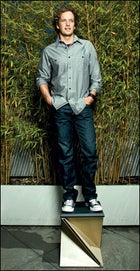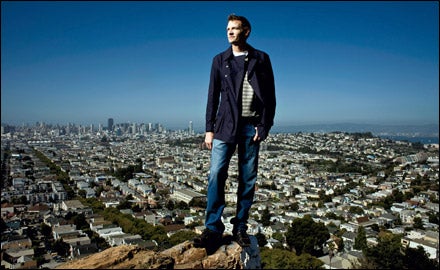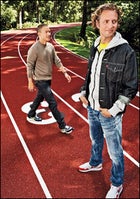Left: On Yee: Nautica solid long-sleeve button-down shirt ($70); Oakley Classic Denim Pant in Utilitarian Vintage ($49) and Time Bomb II 10th Anniversary Edition watch ($2,750); Kenneth Cole New York Dark Room boots ($195)
Right: On Moritz: J.Crew Stockton racing jacket ($795) and Straight-Fit five-pocket vintage cords ($70); Oakley Ransom Tee ($30) and Crosshair sunglasses (from $135)
When you consider that Oakley is known for both revolutionizing performance eyewear and birthing the modern aggro-cool sporting aesthetic, it can be eyebrow-raising to learn that even their most technical designs still begin with a doodle on paper. “We’re trying to appeal to people’s sense of freedom and rebellion,” says senior design director Yee, 41, who’s had a hand in crafting more than 100 products since joining the company in 1993. “That’s not something you can just squeeze out of a computer.” Yee’s latest project, which eventually involved many computers, had him working with Moritz, 38, and other members of Oakley’s Advanced Product Design group on the new Elite collection. The economy-be-damned label includes the $4,000 C Six; each pair requires more than 24 hours of machining. Says Yee, “It’s the culmination of blue-sky ideas merging with real-world physics.”
Synergist Yves Bèhar
Yves Behar

On Bèhar: Nautica solid long-sleeve button-down shirt ($70); Gap Best crewneck T-shirt ($18); Kohzo Raw Crinkle Denim low-waist straight-leg button-fly jeans ($550); Converse Chuck Taylor All-Stars ($45)
When Bèhar was 16, he decided to join his two greatest loves, skiing and windsurfing. He built a scary contraption resembling a Flexible Flyer with a mast and used it to tear across frozen lakes in his native Switzerland. These days, as one of the world’s most sought-after industrial designers, the 42-year-old continues to make surprising combinations. His firm, Fuseproject, which he founded in San Francisco in 1999, provides a unique service to clients, melding product design, branding, and market strategy to compose “seamless experiences and seamless stories” for consumers. Though he’s worked with a diverse list of big labelsSwarovski, Samsung, Birkenstock, and many othershe gravitates toward startups, including One Laptop Per Child, for which he designed the $180 XO computer and a new tablet version, due in 2010; and Mission Motors, which had Bèhar design an electric motorcycle that looks right out of Blade Runner. “There is an expectation that things should be designed ahead of the energy curve,” says Bèhar. “But an electrical motorcycle should still make you feel macho.”
Park Producer James Corner

Ralph Lauren Black Label Escape Lined Utility Jacket ($895), Slim Custom-Fit Regent shirt ($145), and Classic-Fit Steuben Wash Jean ($145)
Corner isn’t much into scenic overlooks. “The deeper part of landscape experience comes through physical engagementusing it,” he says. His most celebrated project thus far, a stunning walking park on Manhattan’s abandoned High Line railroad, will certainly get a lot of use. Eventually, so will the park he’s slowly “growing” at the infamous Fresh Kills landfill, on nearby Staten Island. (His master plan calls for natural soil generation, and it will take some 30 years for the park to be completely open.) Corner, 47, the chairman of the University of Pennsylvania School of Design and principal of James Corner Field Operations, with offices in New York and Philadelphia, is a leading figure in the cadre of landscape architects redefining their profession with massive projects that reclaim disturbed urban spaces and make them, well, fun. To Corner, this means amplifying existing attributeseven garbage mounds. “Using design to heighten experience is different than just laying out a park with trails or open spaces,” he says. “We’re trying to dramatize things.”
Global Seer Peter Birch

G-Star Correct peacoat ($350); J.Crew Merino graphite-stripe V-neck sweater ($62); Banana Republic Fitted cotton crew ($20); J Brand jeans ($227); Fluevog Future Angel Charles shoes ($125)
Ask Birch any question about Google Earth and he’ll work his way back to two themes: making it more powerful and more accessible. This for a program that has already been downloaded more than 500 million times and fundamentally changed the way we plan our adventures. Birch, 41, who has degrees in engineering and business, took over product management in 2006. Since then, Google Earth has introduced ocean imagery, the moon and Mars (Google Solar System?), 3-D models of cities, historical imagery, and the project’s most stunning development since its launch, Google Earth for iPhone. “Five years ago, the idea of being able to hold this in a device in your hand was a fantasy,” he says. “It happened sooner than we thought imaginable.” Birch’s long-term dream is to create a “mirror world that accurately reflects everything.” His main tool: you. “The most powerful part of Google Earth is that it’s a platform,” he says. “Anyone who has geographic information can make it available.”
Number Runners Michael Tchao and Stefan Olander
Michael Tchao and Stefan Olander

Left: On Tchao: J.Crew cashmere crewneck sweater ($188); G-Star 3301 Slim jeans ($200); Nike Air Maxim 1 ($120)
Right: On Olander: Levi’s Slim Trucker Jacket ($90); Nike Sportswear AW77 Hoodie ($80); Nike Sportswear Tee ($35); Revel Seven Organic Vintage Straight Leg 10 Year Wash ($195); Nike Air Pegasus+ ($120)
“There’s nothing more valuable to people than their own achievement,” says Olander, 42, Nike’s director of global brand connections. That’s the basic idea behind Nike+: Give runners a simple system that tracks how fast and far they’re going and they’ll take off sprinting. Released in 2006, Nike+ was hardly the first device to record these numbers. But the gadgetrya sensor embedded in your shoe that wirelessly transmits to your iPodmade the process effortless and cheap ($29 for the first-generation kit). The result: Some two million runners have since started tracking their mileage and uploading the results on (and, more recently, posting challenges and favorite routes). Now, Olander hopes to grow that community by providing more tools to interpret and broadcast numbers, while Tchao, 46, general manager of the Nike TechLab/Nike+, experiments with new data-gathering capabilities in the hardware. “In the space where the physical and digital converge,” says Olander, “we have an amazing opportunity to make sports richer and more funand make athletes better.”


